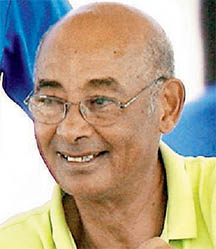By Dr Rudi Webster
Much has been written about the Frank Worrell and Clive Lloyd teams, particularly their domination of world cricket.
Most analysts have attributed those teams’ success to an abundance of physical talent while a few from academia, have highlighted powerful political, social and economic forces.
Those factors contributed to the teams’ success but were not responsible for it.
Without the visionary leadership of Worrell and Lloyd, such success might not have been possible.
They were the right men for the job and the time.
Worrell and Lloyd were astute leaders who knew their players intimately and understood how to get the best out of them.
Most importantly, they helped them to play a better inner game by showing them how to build a positive self-image and team image, how to improve self-belief and self-confidence, and how to develop a feeling of importance and sense of belonging.
The enhancement of these inner resources improved the players’ capacity to identify the challenges in the situations they faced without distorting or magnifying them in any way.
It allowed them to think calmly, clearly and sensibly. It also enabled them to cope better by enhancing their capacity to tailor their skills and resources to meet and capitalize on the challenges.
As situations in the game changed, the players were able to adjust successfully to meet new demands.
Interestingly, the appointment of Worrell, the first black captain, was not universally accepted, nor was the selection of Lloyd, who got the nod over two contenders who were university graduates.
I was fortunate to witness firsthand the birth and early development of Lloyd’s champion team. When Lloyd took over the captaincy, he was presented with inexperienced players who had only played a few Test matches.
However, they all became superstars under his leadership. He led by example, and during the period that he was captain, he established an impressive batting average of 51.
Lloyd brought together a diverse collection of inexperienced but talented players, who lacked direction, focus, discipline, common purpose and a winning philosophy.
In time, he transformed them into a highly-professional and all-conquering unit that dominated world cricket for more than 15 years. That team became one of the best and most successful teams in the history of sport.
People who claim that Lloyd’s success revolved entirely around four fast bowlers should pay attention to his comments: “When I took over the captaincy, I had a lot of ability and skill in my team, but I knew that talent alone would not be enough to transform the unit into a champion team. Other things were needed – a clear vision of what I wanted the team to achieve and become, well-understood and well-practised values, and sound performance principles. Strategic thinking, mastery of the basics and careful preparation were very important. So too were strong self-discipline, good self-motivation, efficient teamwork and high standards of execution. I mustn’t forget good concentration, patience and persistence, mental toughness, and first-class leadership. I wanted my team to be the best batting team, the best bowling team and the best fielding team. I also wanted it to dominate world cricket for at least 10 years.”
Worrell and Lloyd knew that plans and strategies do not accomplish performance. It is the players who get things done. They breathe life and energy into the team’s vision, plans and mission. At the end of the day, it is the competent, well-trained, highly-disciplined and highly-motivated players who are the keys to the team’s success.
During a war, an army needs good administration and management to function but it cannot win battles without innovative leadership at every level throughout its ranks. No one has as yet found how to administer or manage people into battle. They must be motivated to fight. The same applies to sport. In cricket, the battles are fought with balls and bats, but it is the will, spirit and mental strength of the man who leads and the players who follow, that take the team to victory.
Recently, I heard a former West Indies batting coach diagnosing West Indies’ batting problems and articulating the way forward for West Indies cricket. I believe the gentleman served as West Indies batting coach for a number of years and yet, during that time, the team’s batting did not show any significant or lasting improvement.
A famous American football coach once stressed that coaches who can write down plays on a blackboard or articulate their plans clearly are a dime a dozen. He said that the coaches who win, get into the players’ heads, hearts and bellies and motivate. Worrell and Lloyd excelled in that area.
Worrell and Lloyd understood the importance of a positive self-image and always tried to improve it.
They knew that performance is regulated around the players’ self-image and self-beliefs, not around their potential. They also understood the destructive power of a negative self-image.
A player’s self-image is his subconscious picture of himself. It’s his inner picture of who he is and what he expects of himself. It is so powerful that it controls not only what he presently is, but also what he will be in the future.
It also determines how much potential he will use.
The player’s self-image is not fixed. He can change it whenever he wishes. If he is unhappy with his life or his game, he can improve them by changing the picture he has of himself.
All meaningful change first starts on the inside and works its way out.
If the player changes the pictures of what he believes, he will automatically change what he achieves.
Psychologist William James once said that the greatest discovery of our time is that man, by changing the inner aspect of his mind, can alter the outer aspect of his life.
Too often, people in the Caribbean believe that they are not good enough; something is not working and needs to be fixed; something is missing and something special needs to be added to make them worthwhile. These limiting beliefs hide the wealth within,
Players shouldn’t waste their time looking for a secret to success. The secret already lies within them. They should work instead to develop their own system of success. The thoughts, values and pictures that they imprint in their minds today will determine what they become tomorrow. Worrell and Lloyd knew these things and helped the players to tap into their inner wealth.
That approach enhanced the players’ self-belief and self-image and motivated them to accept co-ownership and co-responsibility for the teams’ goals and performance. Last but not least, it helped to eradicate a great portion of the insularity that had compromised and sabotaged the performance of other West Indies’ teams.






